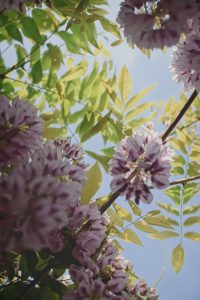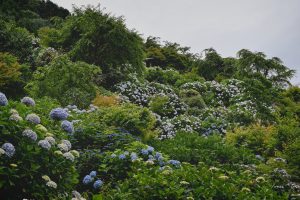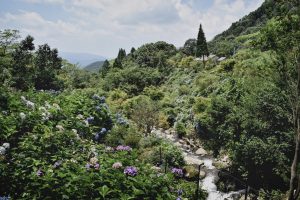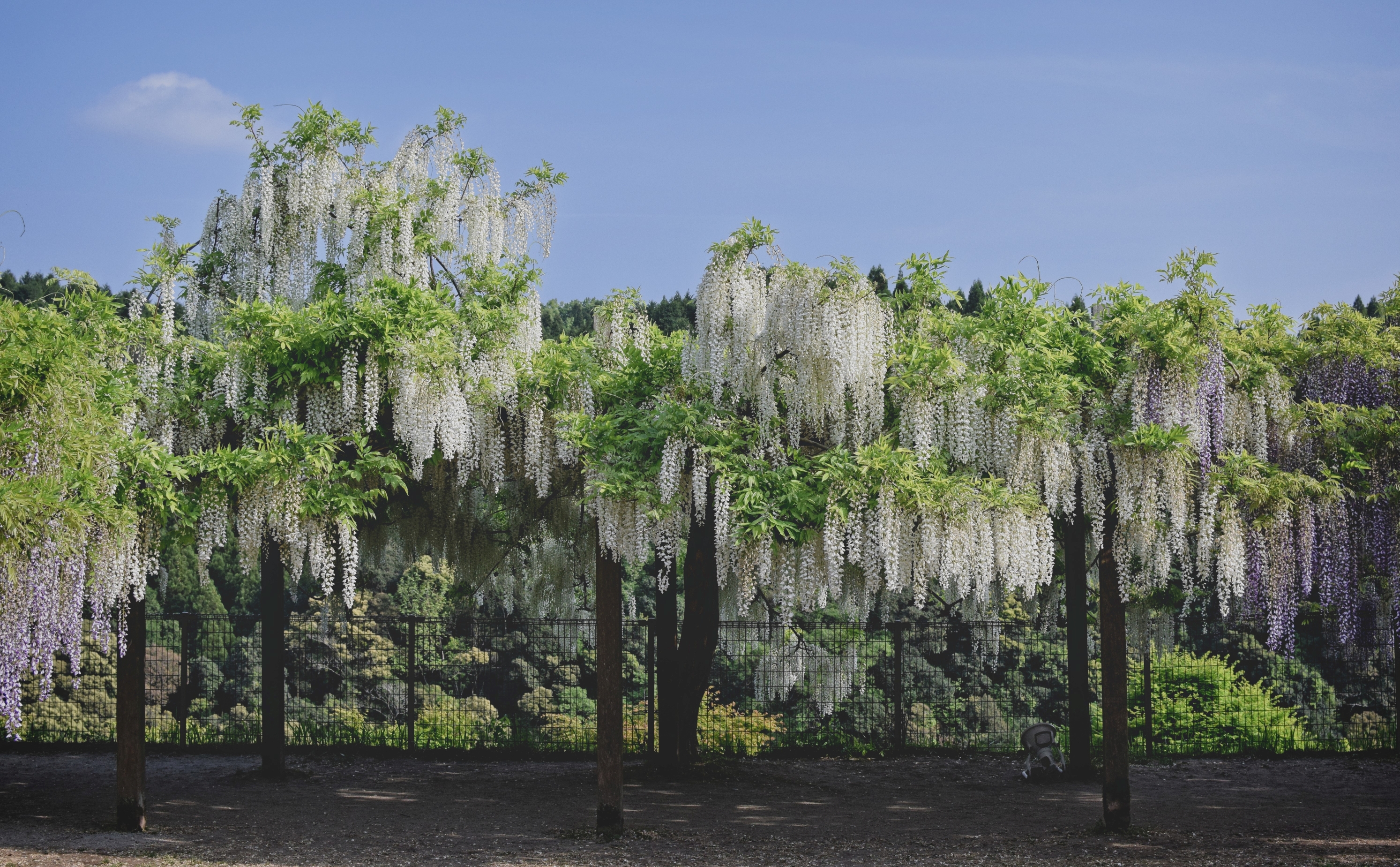This article originally featured in the March 2020 issue of Connect.
Ailsa van Eeghen (Kagoshima)
 Wake Shrine Wisteria Festival (和気神社藤祭り)
Wake Shrine Wisteria Festival (和気神社藤祭り)
Up in the mountains of Kirishima is the beautiful Wake Shrine (和気神社). Overlooked for most of the year, the shrine comes to life during the month of May when the vast wisteria vines burst into life. Completely surrounded by trees up on a hill, arriving at the flower festival is like arriving at your own little haven in the mountains.
Just as we arrived, the kyumen taiko drum troupe began their performance. Wearing tengu (a type of Japanese mythological creature) masks and swaying their bodies madly, it really felt like we were watching a performance played by demons. But nothing could truly distract us from the beautiful flowers beckoning us to enjoy them.
As we walked under the trees bees hummed lazily, enjoying their bounty. Planted to create a roof-like structure, the wisteria sparkled overhead as light leaked through. It is said that gardens and flowers have a way of bringing people together, drawing them from their homes. And as I watched the light-dabbled faces of those around me, their eyes and smiles bright and full with happiness, I knew that coming here was and will continue to be a great idea.
 Shinonome no Sato Hydrangea Garden (東雲の里紫陽花園)
Shinonome no Sato Hydrangea Garden (東雲の里紫陽花園)
As the thick, cloying warmth of summer sets in, the nature of my prefecture comes alive. There is nothing, however, that truly signals the start of summer like bushes of hydrangeas springing to life. Fortunately for myself, I live in a town where you can see one of the best hydrangea gardens in the prefecture. For hidden up in the mountains, just outside of Izumi, is a magical valley bursting with hydrangeas.
Shinonome no Sato (東雲の里)is a huge garden nestled in the valley of a mountain. Driven by the desire to make a place where he can display his creations, Miyagi Makoto decided to create a space of his own. Illuminated by car lights, Miyagi cut through the overgrown trees, discovering long forgotten stone walls and terraced rice fields. In 1995, the garden was opened and has been welcoming visitors ever since.
Every year I take the drive up there, and every time it feels like I’m stepping into a different world. Following the path, we’re soon surrounded by lush, green nature. A rich warm smell is coming from the soba restaurant tucked away amongst the leaves. All around us are small clay creatures, probably hand-crafted by the owner himself.
 Our stroll takes us past moss-covered houses, through rows of hydrangeas and up to a waterfall. We take in views of the valley, dotted with colour from all the flowers. We pass by walls of hydrangeas, their heads bobbing as we slide by. That ever-present summer hum fills our ears as we take a rest, taking in the expansive views around us. “This doesn’t feel like Izumi,” I say to my friend. “I feel like I’ve stepped into a fairytale.”
Our stroll takes us past moss-covered houses, through rows of hydrangeas and up to a waterfall. We take in views of the valley, dotted with colour from all the flowers. We pass by walls of hydrangeas, their heads bobbing as we slide by. That ever-present summer hum fills our ears as we take a rest, taking in the expansive views around us. “This doesn’t feel like Izumi,” I say to my friend. “I feel like I’ve stepped into a fairytale.”
Uwaba Cosmos Garden(上場コスモス園)
It’s October. The days are shorter. The wind is cooler. And the roadsides come to life as cosmos flowers bloom seemingly out of the grass. “It’s time to go to Uwaba,” I tell my friend.
Our drive takes us through the mountains of Izumi, up to the highlands of Uwaba (上場). What was once just a hill has been turned into a huge flower park for the months of autumn. Each year, the local people come together to plant over a quarter of a million flowers. For these few months the souvenir shop comes to life, selling local produce and fresh ice cream made from the local milk. From around the neighbourhood, the people of Uwaba gather to greet those who have come to see the sea of cosmos.
 Arriving in the late afternoon, we had the place to ourselves. The cosmos spread out before us, gently swaying in the wind. Shades of pink and white dotted the landscape as we strolled through the fields. ‘What a perfect picnic spot this would make,’ I thought to myself. We watched the sun set over the mountains, before eventually accepting that it was time to leave. Walking back down the hill, we enjoyed the view of the flowers for the last time, the cosmos spreading out before us like some kind of living carpet. The sounds of cows slowly drifted away as we headed back down the mountain.
Arriving in the late afternoon, we had the place to ourselves. The cosmos spread out before us, gently swaying in the wind. Shades of pink and white dotted the landscape as we strolled through the fields. ‘What a perfect picnic spot this would make,’ I thought to myself. We watched the sun set over the mountains, before eventually accepting that it was time to leave. Walking back down the hill, we enjoyed the view of the flowers for the last time, the cosmos spreading out before us like some kind of living carpet. The sounds of cows slowly drifted away as we headed back down the mountain.
All Photos: Ailsa van Eeghen
Ailsa van Eeghen is an ALT and photographer who has been living in Kagoshima Prefecture for four years. She usually spends her weekends with her camera searching for the best swimming spots, the wildest festivals or hiking up mountains. You can find more of her pictures on Instagram at @ail.saa and on her website where she writes about her travels.




